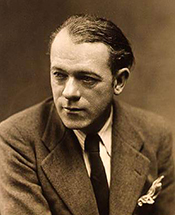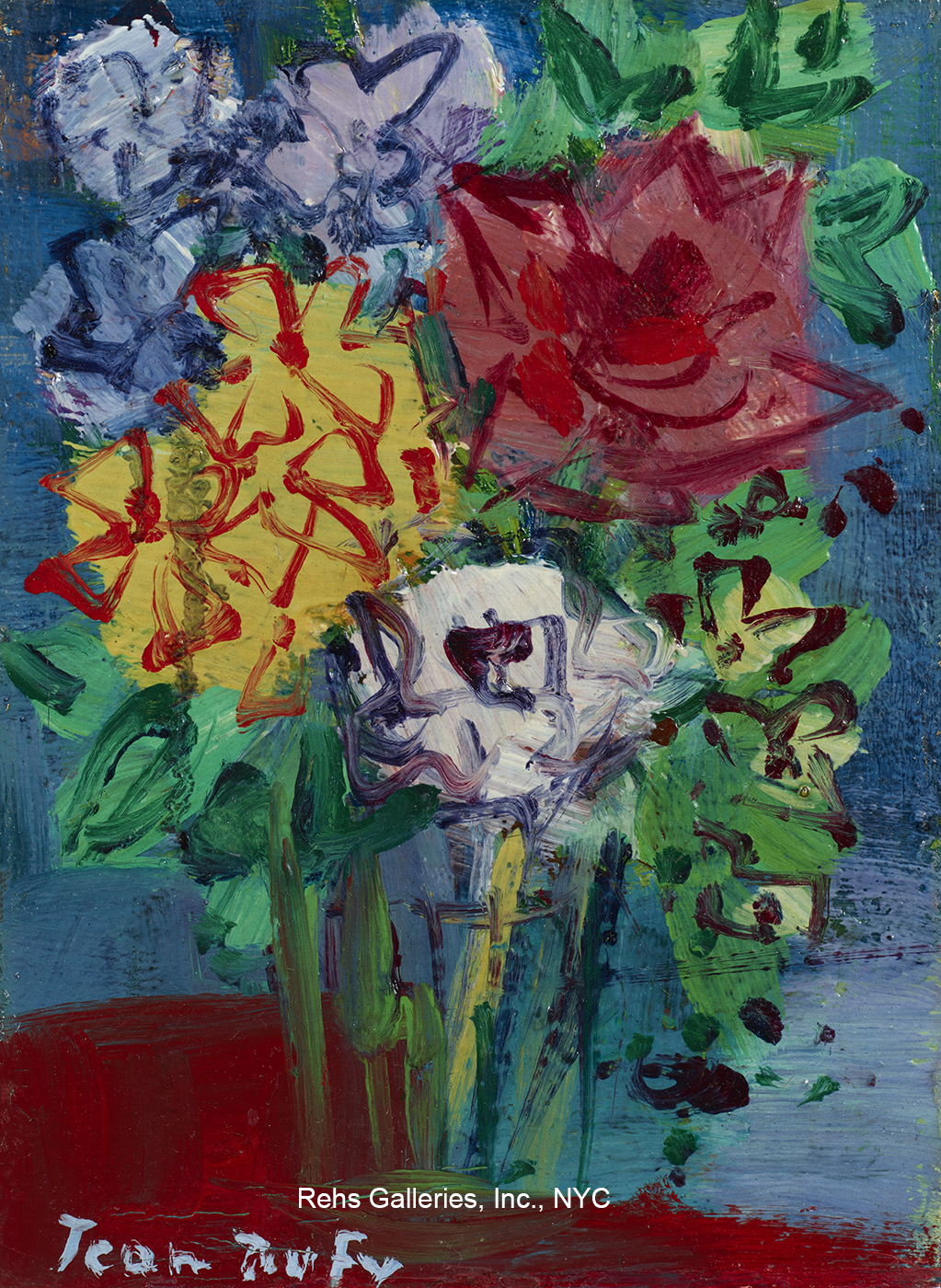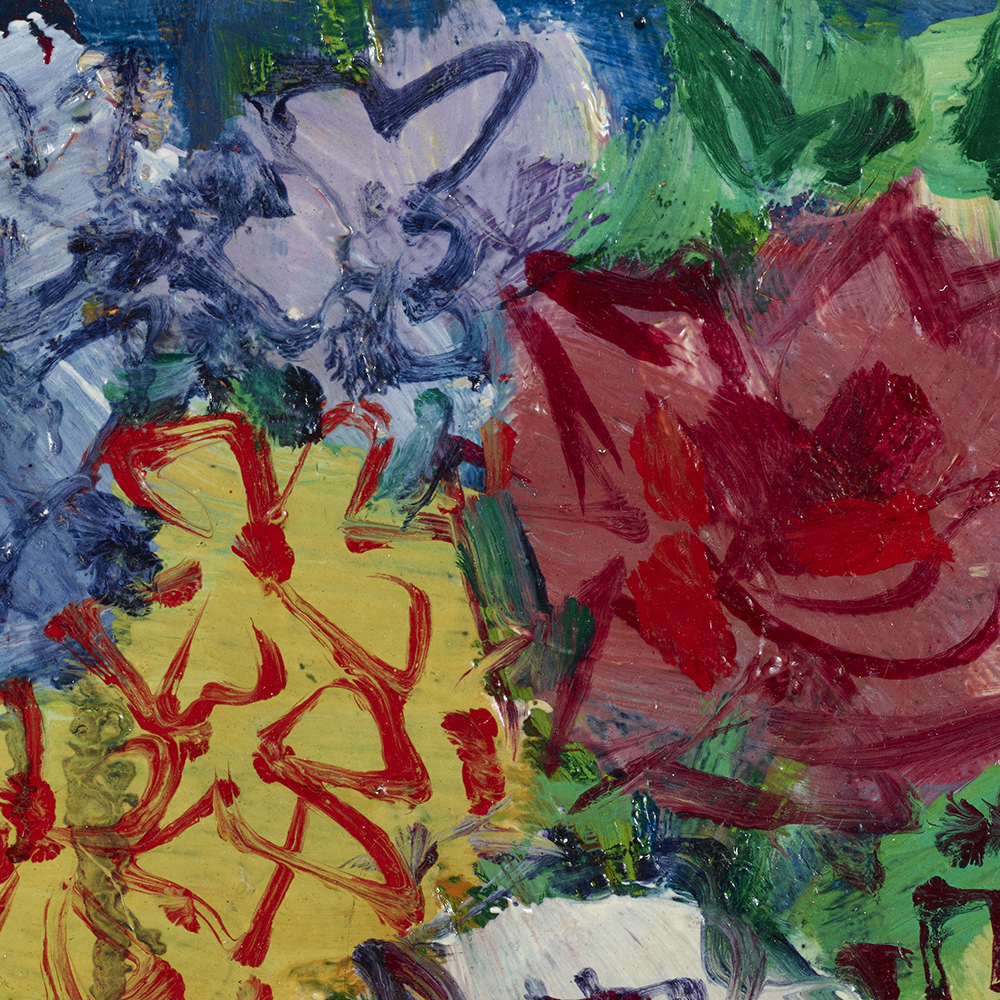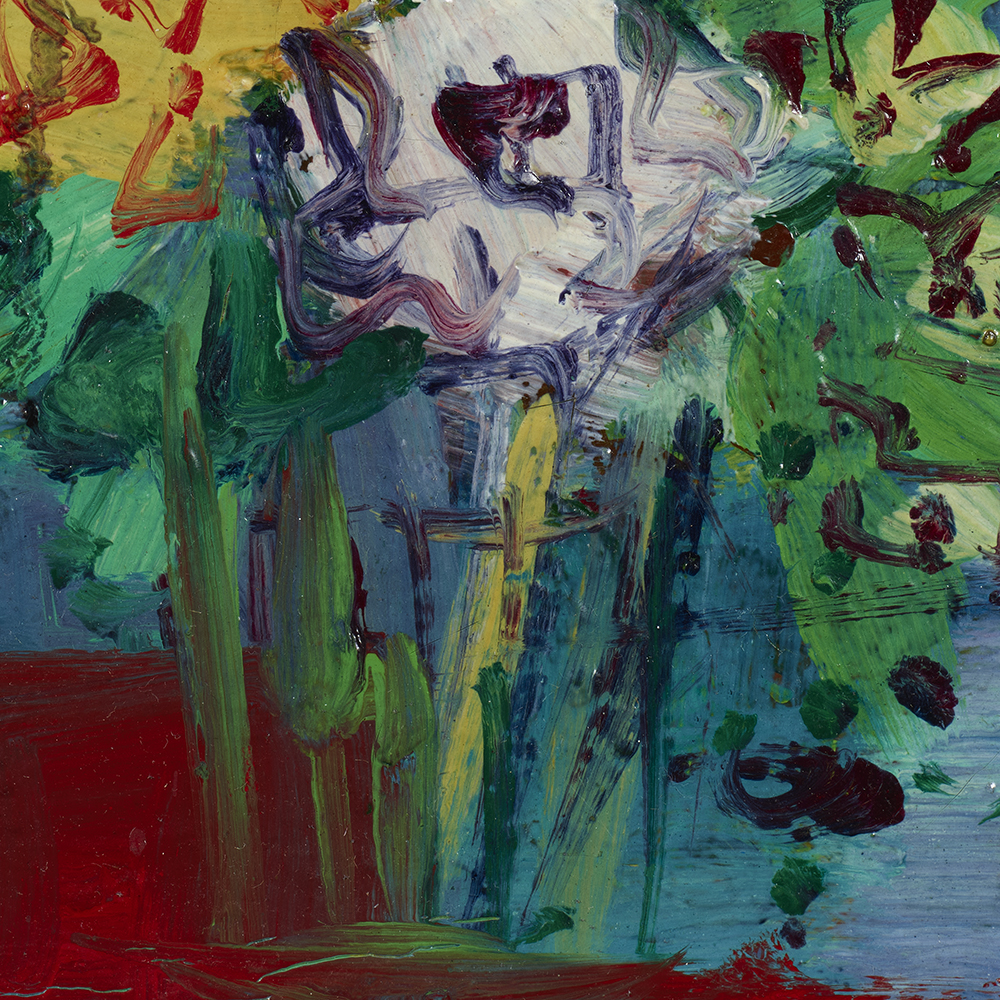Jean Dufy
(1888 - 1964)
Bouquet de Fleurs
Oil on canvas
8.625 x 6.375 inches
Framed dimensions:
14.5 x 12.5 inches
Signed
BIOGRAPHY - Jean Dufy (1888 - 1964)

Jean Dufy’s lengthy career encompassed both design and painting during a period of time characterized primarily by warfare and its subsequent repercussions. He was born in Le Havre, France, on March 12, 1888, to Léon Dufy and Marie Eugénie Ida Dufy, the seventh of eleven children. His father was an accountant for a metallurgy company, which allowed him to provide for his ever expanding family, and he was also a gifted musician who would eventually become the official organist of Notre Dame church in Le Havre. All of the Dufy children would receive an exceptional musical education, and the eldest son Léon would become a professional organist. Raoul also played the organ while the third son Gaston was a talented flautist while Jean, the youngest son, took up both piano and guitar.
Like his brothers and sisters, Jean Dufy attended the public schools in Le Havre, receiving his certificate d’études primaries élémentaire on July 9, 1901. [i] From there he went on to study for his certificate d’études primaries supérieures, focusing on business. His father, however, could not afford to fund his continuing education, and at age sixteen, Dufy began working for an export company. He described the office environment in which he found himself as “stifling, although my job as a commercial agent meant I spent time at the harbor among all the exotic products being unloaded from the cargo ships like so much treasure.” [ii] This world of travel and adventure was faithfully recorded in Dufy’s sketchbooks where he captured the daily activities of loading and unloading cargo as well as the sailors and merchants from faraway places. Jacques Bailly, author of the Dufy catalogue raisonné, notes that ‘the pleasures of the intellect counterbalanced his fascination with this wealth of images as he perused Baudelaire, Mallarmé, Rimbaud—all ‘mystics of travel’, as he referred to them in his biographical notes.” [iii]
While the younger Dufy was wandering the docks of Le Havre, his brother Raoul was establishing himself as a painter. Eleven years older than Jean, Raoul was exhibiting with the Fauves painters and co-founding Le circle de l’art moderne together with Georges Braque and Othon Frieze. Their first exhibition was at the town hall of Le Havre in May-June 1906; other participants included Henri Matisse, André Derain, Pablo Picasso, Charles Camoin and Henri Manguin. It was here that Jean Dufy first saw Matisse’s painting, Fenêtre ouverte, Collioure, which would become an important inspiration for his own art in the near future.
The lure of adventure—and undoubtedly a desire to escape the office routine—led Dufy to apply to the Compagnie Générale Transatlantique for a position as secretary to the manager of the ocean liner, La Savoie. His fluency in both English and German sealed the deal; his job was to collect and prepare all the necessary paperwork for immigration officials in New York. He set sail in January 1907 and arrived at the port of New York two weeks later in a snowstorm. Although his income was too modest to permit him to enjoy the city extensively, he did manage to take in a number of musical and theatrical performances over the next eighteen months.
Dufy’s enjoyment of his transatlantic life ended only because he was obliged to report for his mandatory military service in 1910; until late 1911, he was part of the 7th regiment of chasseurs à cheval (a cavalry unit). After completing his military duty, he settled in Paris—exploring the capital city for the first time. He found an apartment on the Square Caulaincourt in Montmartre, several miles northwest of the now iconic Place du Tertre and Sacre Coeur. It was a very modest part of the city, but full of artists.
Among them were the men whose work he had admired in the 1906 exhibition in Le Havre—Derain, Picasso, Braque—but he also met the poets Guillaume Apollinaire and Max Jacob as well as the art dealer and gallerist, Berthe Weill. In his autobiographical notes, he wrote: “I painted with Marquet, Raoul, and Friesz, who were beginning their difficult experience in Paris. They were very kind to me and I was included in their discussions about painting, where I listened open-mouthed but carefully to everything they said. My vocation received precious support at that time.” [iv] By January 1914, Dufy had his first solo show of thirty watercolors at Weill’s gallery at 25 rue Victor Massé near the Place Pigalle.
During this brief period before World War I, Dufy also began to design fabric for the silk factory, Soierie Georges in Lyon. According to his own notes, Dufy earned good money and was happy to be experimenting with color combinations for the textiles. [v] All of this activity came to an abrupt halt on August 2, 1914 when Dufy was again called up for military service and dispatched to the Belgian border as an ambulance driver with the 24th Infantry. By 1917, he had been assigned to the heavy artillery unit. After fifty-two months of service and weighing only 45 kilos (99 pounds), he was finally demobilized in 1919. Immediately after being discharged, he stayed at Le-Val-d’Ajol in the Vosges mountains near the region where he had been stationed, probably to recover his health and peace of mind before returning to Paris.
The post-war period in Paris was an extraordinary time. The city was once again the international capital of the art world, full of new ideas and the exuberance that comes from surviving a world war. Artists, poets, playwrights, and musicians arrived from all over the world. The Dadaists from Zurich and Berlin showed up early in the decade, as did those—like Marcel Duchamp and Francis Picabia—who had taken refuge in New York. Irish writers and American journalists—James Joyce, Ernest Hemingway, and F. Scott Fitzgerald—held down Parisian barstools for years. Gertrude and Leo Stein were entertaining all sorts of avant-garde artists at their weekly salons. And African American jazz musicians returned to the city of light to live free of the oppression of Jim Crow laws in the US. [vi] The “Jazz Age” had begun.
When Dufy returned to 2 Square Caulaincourt in 1920, he too became part of this new world; a world where traditions and long-standing institutions no longer commanded respect, and where the class structures of pre-war society no longer applied. [vii] One of the earliest indications of this new spirit was a farcical ballet, Le Boeuf sur le toit (The Ox on the Roof), composed by Darius Milhaud with a script by Jean Cocteau and set design by Raoul Dufy—with the anonymous assistance of his brother Jean. The production opened on February 21, 1920 at the Comédie des Champs-Elysées with the clowns from the Cirque Medrano, the Fratellini Brothers, acting out the pantomime. The set was designed to look like a slightly seedy bar where the various characters—a bookie, a boxer, a woman in man’s clothing (quite shocking for the time), a dwarf, and a policeman—move in slow motion through the pantomime. In contrast, Milhaud’s music provided an upbeat Brazilian-influenced jazz. The production was one of several pieces presented that evening, including new compositions by Francis Poulenc and Erik Satie. For Jean Dufy, this introduction to the Dadaist-Surrealistic arts community would prove to be seminal for his development.
As Dufy settled into life in Paris, he continued to design textiles, now in association with Raoul’s fabric design studio, which provided watercolor and gouache patterns for the silk manufacturers Bianchini-Férier in Lyon. He also pursued ceramic design work that he’d begun before World War I. Fortunately for Dufy, he met William Haviland in August 1921 during his vacation in the village of Bussière-Poitevine in Limousin region, about twenty miles northwest of Limoges; Haviland had recently assumed the position of Director of the Haviland Porcelain Manufactory after the retirement of his father, Théodore. Their meeting marked the beginning of a partnership that would last for many years.
During the early 1920s, Dufy’s also met Ismérie Louise Coutut, who would become his wife on December 30, 1922. She was born in Preuilly-sur-Claise on May 21, 1899, a small town in the Tourraine region where the couple would often spend several months each year. The first year of marriage proved to be both happy and productive. In February 1923, Haviland produced the first of a series of plates known as the “décor Dufy”, this one based on a design featuring a basket of fruit in the center of the porcelain plates; in August, William Haviland purchased three more designs. Two of Dufy’s paintings were equally well received that year at the Salon d’Automne: Nature morte au paysage and Nature morte. And in late November, Lawrence d’Albis, brother-in-law of William Haviland, purchased one of Dufy’s paintings for 800ff.
Throughout the 1920s, Dufy created numerous designs for Haviland, some of which have become justifiably famous. The “Châteaux de France” series in particular marks a change from traditional patterns to a more modern sensibility, utilizing sixteen shades of color on a crisp white porcelain background. This design was featured on the table service that Haviland exhibited at the Exposition Internationale des Arts Décoratifs et Industriels Modernes in 1925, the fair that introduced art deco design to the world.
In addition to his design work, Dufy continued to pursue his career as a painter, consistently exhibiting his work at the annual Salon d’Automne as well as at galleries in Paris, Limoges, and New York during the 1930s. In the early years after his return from war, he typically favored watercolor or gouache as he experimented with all of the new aesthetic directions he was absorbing in Paris. Many of those images reflect the work of Paul Cézanne and Matisse, seemingly contradictory influences, but entirely appropriate for a young artist trying to understand the varying directions that his predecessors had explored. As he grew more confident of his own style, he began to adopt surrealistic elements, employing dislocated objects in space, intense coloration, and sharp shifts in scale and proportion.
Dufy also began to travel extensively, a habit that he would maintain throughout his career. The region around his hometown, Le Havre, and the Tourraine region, home to his wife’s family, were always on his travel itinerary. In 1926, however, he made his first trip to Villefranche-sur-Mer in the south of France and then to Venice. By 1927, he was successful enough to move to a new home in the leafy Paris suburb of Garches on the western bank of the Seine, staying there until 1936 when he and Ismérie moved to the small village of Abilly, not far from Tours. This location offered the advantage of being closer to Ismérie’s family, as well as being less expensive during the Great Depression.
Like everyone else, Dufy had to manage his budget carefully during the 1930s. He was able to maintain his relationship with Haviland, but at a much reduced level of production. [viii] In 1934, however, he added the Manufacture Nationale de Sèvres to his client list, preparing four designs for ceramic plates. Two years later, Sèvres produced three additional designs by Dufy.
One of the largest projects of Dufy’s career—and one of the most bittersweet—was his work on the mural for the “electricity pavilion” for the 1937 Exposition Internationale des Arts et Techniques dans la Vie Moderne. The Compagnie Parisienne de Distribution de l’Electricité (CPDE) hired the internationally recognized architect Robert Mallet-Stevens to design the building and Raoul Dufy to coordinate the interior decorative painting; the only guideline was that the 600 square meter space celebrate electricity. Raoul in turn hired Jean Dufy, André Robert and Jacques Maroger to assist in the project. Jean Dufy was responsible for conducting extensive research on the development of electricity, including 919 images of scientific experiments from the eighteenth and nineteenth centuries. He also researched the costumes appropriate to the historical period with the help of costume designers from the Comédie Française and had the actors come to the studio to pose in costume as a means of establishing the composition of the entire mural. He described his role in this undertaking, “In a way, I was staging the show. With all these elements in hand, I worked on the sketches, looking for compositions that would connect the different scenes and create a movement from ancient times to the present.” [ix]
When the completed Pavillon de la Lumière et de l’Électricité opened on the Champs de Mars on May 24, 1937, the mural—now titled La Fée Electricité (The Electric Fairy)—was an immediate sensation. [xi] When Jean Dufy read the media coverage of this project, however, he learned that Raoul Dufy claimed all credit for the work. Not surprisingly, he was deeply hurt that his brother would fail to acknowledge his significant contribution to the project. It created a rift that would continue for several years.
The decade closed with a notable exhibition of modern paintings at the Portland Art Museum in Maine. Three of Dufy’s paintings—one of which was featured on the cover of the exhibition catalogue—were included together with canvases by Marc Chagall, Amadeo Modigliani, André Derain and Picasso. [xii] Not only does this event mark Dufy’s first museum exhibition in the US, but it also indicates the interest in contemporary art among American collectors. The year closed with a French declaration of war against Nazi Germany in September of 1939. Dufy and Ismérie moved from Abilly to the small town Preuilly-sur-Claise where she was born. Although they soon found themselves living in Nazi occupied territory, Dufy continued to work on small scale images. He produced a series of woodcut images of the town and numerous watercolors and gouaches of the surrounding areas. More important was the re-establishment of communication with Raoul, who wrote to Jean in March, 1943: “I will not attempt to explain my lack of correspondence, I admit I’ve completely failed to write.” [xiii]
The post-war years provided a welcome contrast to the hardship of the previous decade. Dufy’s work was in constant demand. His popularity in the US continued to grow, and in fact, his first exhibition after the cessation of hostilities was in Philadelphia in 1947. That was followed in quick succession by shows in Boston, New York and Montréal in the 1950s. The Paris galleries were eager for his work as well, albeit slower to recover from the damages caused by five years of occupation by a hostile power. Jeanne Le Chapelin of the Galerie J. Le Chapelin on rue du Faubourg Saint-Honoré, began seeking Dufy’s paintings in May, 1950, asking if he would consider “accepting me as one of your galleries. I greatly appreciate your work and often exhibit it in the gallery window. The Gallery is extremely well located, and I would be delighted if you could send me a few gouaches of Paris.” [xiv] Dufy did indeed accept her offer and was soon sending his paintings to Paris on a regular basis.
By the mid-1950s, he also began to travel again. He made a trip to Stockholm in 1953, shortly after the death of Raoul on March 23. That was followed by a journey through North Africa in 1954 and to Naples, Rome, Florence and Venice in 1955. In 1957, he visited Corsica in May and then England, Scotland and Ireland in August-September. The year 1958 opened with an extended stay in Marseille, then a trip to Vienna in March; Denmark, Sweden, and The Netherlands from June through August, and a visit to Madrid and Granada in November-December. In 1959 he was in Spain and Portugal in May and June, and then visited Italy in September. By 1960, the traveling slowed significantly, perhaps in order to complete the remarkable number of paintings that his patrons requested.
During his last few years Dufy’s production of paintings, watercolors, gouaches, and the occasional lithograph was unabated. His work was being shown internationally—and it was selling extremely well. All of this came to a standstill on March 11, 1964 with the death of Ismérie, his constant companion and much loved wife. Dufy was overwhelmed with grief. With encouragement from his close friend Jean Colin, he returned to his art by late March, but only on “small colored drawings of shells.” [xv] In spite of this effort to continue working, Dufy died two months after his wife on May 12, 1964.
Janet Whitmore, Ph.D.
Selected Museums
Art Institute of Chicago
Brandywine River Museum Chadds Ford, Pennsylvania
Centre Pompidou, Paris
Davis Museum, Wellesley College, Wellesley, Massachusetts
Detroit Institute of Arts
Georgia Museum of Art, University of Georgia, Athens
Greenwich House Music School, New York
Laguna Art Museum, Laguna Beach, California
Los Angeles County Museum of Art
Mildred Kemper Art Museum, Washington University, St. Louis
Muscarelle Museum of Art, College of William & Mary, Williamsburg, Virginia
Musée d’Art Moderne, Paris
Musée des Beaux Arts, Caen, France
Musée des Beaux-Arts, Menton, France
Museum of Modern Art, New York
New Orleans Museum of Art
North Carolina Museum of Art, Raleigh
Phoenix Art Museum
[i] Jacques Bailly, Jean Dufy, Catalogue raisonné de l’oeuvre, vol. I, (Paris: Editions Jacques Bailly, 2002) 75. The certificate d’études primaries élémentaire is roughly equivalent to graduating from middle school in the US. The certificate d’études primaries supérieures, which Dufy hoped to receive, would be equivalent to a high school diploma plus a year of college in the US.
[ii] Ibid. This comment comes from Jean Dufy’s autobiographical notes, presumably written with the intention of producing a book at some future point. The notes are included in the Dufy family archives. 75.
[iii] Ibid., 16.
[iv] Ibid., 77,
[v] Ibid.
[vi] African American soldiers who fought during World War I were under the command of the French military because the US generals would not accept them. Most were assigned to supporting roles, but 177 of them received the French Legion of Honor medal for their service. Because of the warm welcome they received there, many of these soldiers chose to return to France in the 1920s. See The Library of Congress, “African American Odyssey: A Quest for Full Citizenship” exhibition website at: https://www.loc.gov/exhibits/african-american-odyssey/world-war-i-and-postwar-society.html
[vii] One of the most engaging books on this period is Kiki’s Paris, Artists and Lovers 1900-1930 by Billy Klüver and Julie Martin (New York: Harry N. Abrams, Inc., Publishers, 1989). It is a detailed photographic compendium of the arts community of Paris during these years with commentary about the individuals involved.
[viii] The Haviland Company exported 70% of its products to the US in the late 1920s and was seriously affected by the 1929 stock market crash. Dufy remained a regular designer for the firm, but at a much reduced quantity. See Jacques Bailly, Jean Dufy, Catalogue raisonné de l’oeuvre, vol. I., 89.
[ix] Jacques Bailly, Jean Dufy, Catalogue raisonné de l’oeuvre, vol. I., 95.
[xi] The mural, La Fée Electricité, is now installed at the Musée d’Art Moderne, Paris.
[xii] Exhibition of Modern Paintings, December 30 to January 31 (Portland, ME: The Portland Art Museum, 1938). Exhibition catalogue. The museum today is known as the Portland Museum of Art.
[xiii] Jacques Bailly, Jean Dufy, Catalogue raisonné de l’oeuvre, vol. I., 95.
[xiv] Ibid., 99.
[xv] Ibid., 103. Bailly notes that Jacqueline Kennedy, who was a student in Paris in the 1950s, purchased one of Dufy’s gouaches of sea shells which she later hung in the White House.



